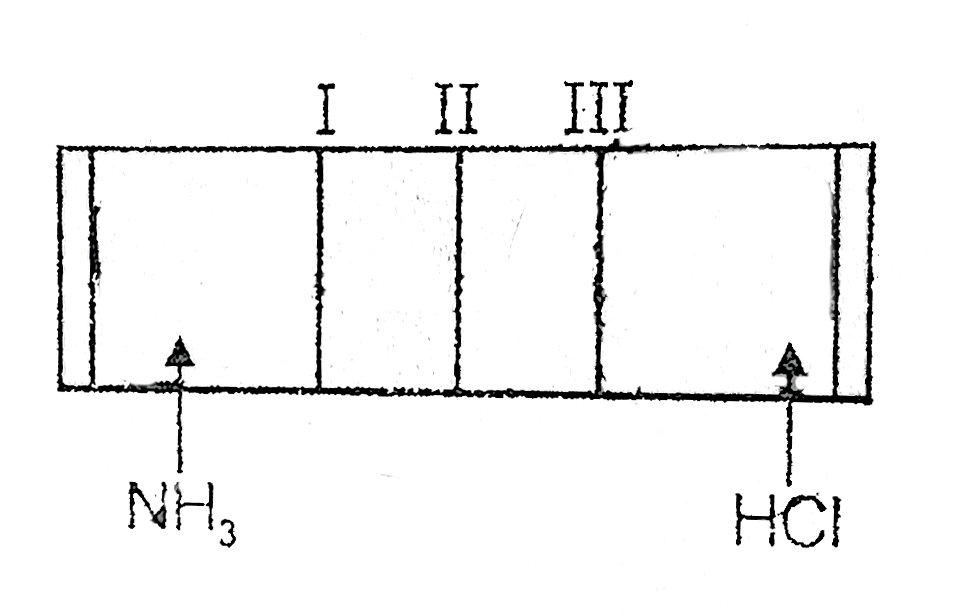The reaction between gaseous and HBr produces the white solid . Suppose that and HBr are introduced simultaneously into the opposite ends of an open tube that is 1 metre long. Where would you expect the white solid to form ?
Suppose the two gases meet to form a white solid at a will of cm from the end. Thus from the HBr end, the distance will be .
We have,
Since the rate of diffusion is proportional to the distance, the molecules travel.
.
Topper's Solved these Questions
- PROPERTIES OF GASESBOOK - RC MUKHERJEECHAPTER - PROPERTIES OF GASESEXERCISE - PROBLEMS
41 Videos
- PROPERTIES OF GASESBOOK - RC MUKHERJEECHAPTER - PROPERTIES OF GASESEXERCISE - OBJECTIVE PROBLEMS
5 Videos
- PROBLEMS BASED ON EQUATIONS: STOICHIOMETRY BOOK - RC MUKHERJEECHAPTER - PROBLEMS BASED ON EQUATIONS: STOICHIOMETRY EXERCISE - OBJECTIVE PROBLEMS
15 Videos
- SOLID AND LIQUID STATES BOOK - RC MUKHERJEECHAPTER - SOLID AND LIQUID STATES EXERCISE - OBJECTIVE PROBLEMS
51 Videos
Similar Questions
The reaction between gaseous NH3 and HBr produces a white solid NH4Br. Suppose that NH3 and HBr are introduced simultaneously into the opposite ends of an open tube of 1 metre length. Where would you expect the white solid to form?
View SolutionThe reaction between gaseous NH3 and HBr produces a white solide NH4Br. Suppose a small quantity of gaseous NH3 and gaseous HBr are introduced simultaneously into opposite ends of an open tube which is one metre long. Calculate the distance of white solid formed from the end which was used to introduce NH3
View Solution
Knowledge Check
Two pieces of cotton wool soaked separetely in aqueous solution of NH3 and HCl are placed at opposite ends of a close glass tube as shown in diagram

Select nearest position where white solid is formedAIBIICIIIDWhite solid does not formedA bottle of dry NH3 and another bottle of dry HCl connected through a long tube are opened simultaneously at both ends of the tube. The white ring (NH4Cl) first formed will be
AAt the centre of the tubeBNear the HCl bottleCNear the ammonia bottleDThroughout the length of the tubeWhen two cotton plugs, one moistened with ammonia and the other with hydrochloric acid, are sumulataneously inserted into opposite ends of a glass tube 87.0 cm long, a white ring of NH4Cl forms where gaseous NH3 and gaseous HCl first come into contact.
NH3(g)+HCl(g)→NH4Cl(s)
At what distance from the ammonis-moistened plug does this occur?A51.7 cm from NH3 endB51.7 cm from HCl endC43.5 at mid pointDNone of these
The reaction between gaseous NH3 and HBr produces a white solide NH4Br. Suppose a small quantity of gaseous NH3 and gaseous HBr are introduced simultaneously into opposite ends of an open tube which is one metre long. Calculate the distance of white solid formed from the end which was used to introduce NH3
View SolutionA bottle of dry NH3 and another bottle of dry HCl connected through a long tube are opened simultaneously at both ends of the tube. The white ring (NH4Cl) first formed will be
View SolutionWhen two cotton plugs, one moistened with ammonia and the other with hydrochloric acid, are sumulataneously inserted into opposite ends of a glass tube 87.0 cm long, a white ring of NH4Cl forms where gaseous NH3 and gaseous HCl first come into contact.
NH3(g)+HCl(g)→NH4Cl(s)
At what distance from the ammonis-moistened plug does this occur?
View Solution
In the above diagram, the paired open spheres represent H2 molecules and the paired solid spheres represent N2 molecules. When the molecules in the box react to form the maximum possible amount of ammonia (NH3 molecules, what is the limiting reactant and how many molecules of NH3 can be formed?
View SolutionIn the following diagram,container of NH3 gas and container of HCl gas, connected through a long tube, are opened simultaneously at both ends, the white NH4Cl ring first formed will be at Q point. If OP=40cm, then find OQ -

View Solution
